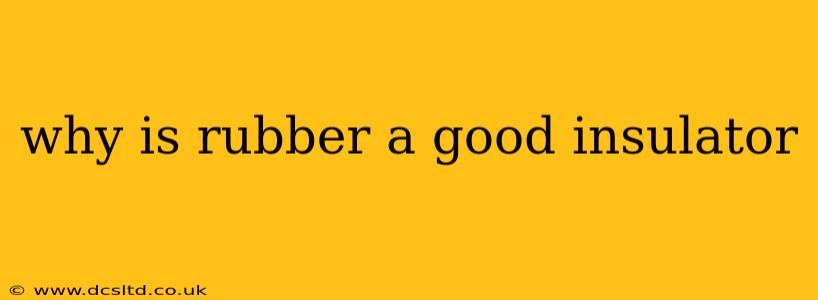Rubber's excellent insulating properties make it a crucial material in countless applications, from electrical wiring to protective gloves. But what exactly makes it such a good insulator? This comprehensive guide delves into the science behind rubber's insulating capabilities, exploring its molecular structure and practical applications. We'll also address some frequently asked questions surrounding rubber's insulating properties.
What Makes Rubber a Good Electrical Insulator?
The key to understanding rubber's insulating properties lies in its molecular structure and the behavior of electrons within that structure. Rubber is a polymer, meaning it's made up of long chains of repeating molecules. These chains are largely non-polar, meaning they don't have a significant positive or negative charge at either end. This non-polarity is crucial because it restricts the movement of electrons.
Electrical conductivity relies on the free movement of electrons. In materials like metals, electrons are delocalized and can move freely throughout the material, allowing for easy current flow. In rubber, however, the electrons are tightly bound within the molecular structure. This lack of free electrons makes it extremely difficult for an electrical current to pass through. The high resistance to electron flow is what defines rubber as a good insulator.
Different types of rubber exhibit varying degrees of insulating properties. For example, natural rubber generally possesses better insulation properties than many synthetic rubbers. The specific formulation and processing of the rubber also impact its overall insulating performance.
How Does Rubber's Structure Affect Its Insulating Properties?
The long, tangled chains of molecules in rubber create a complex three-dimensional structure. This intricate network hinders the movement of electrons, further contributing to its high electrical resistance. The presence of fillers and additives during the manufacturing process can also affect this structure and, consequently, the insulating capabilities. Some additives can enhance the insulating properties, while others might slightly decrease them. The choice of additives depends on the specific application and desired properties of the final rubber product.
What are the Different Types of Rubber Used as Insulators?
Several types of rubber are commonly used for insulation, each with its own set of advantages and disadvantages. These include:
- Natural Rubber: Known for its excellent dielectric strength and flexibility.
- Neoprene (polychloroprene): Offers good resistance to oils, chemicals, and weathering, making it suitable for harsh environments.
- Silicone Rubber: Maintains its flexibility and insulating properties over a wide temperature range.
- EPDM (ethylene propylene diene monomer): Excellent resistance to ozone and weathering.
- Butyl Rubber: High resistance to gases, making it suitable for applications needing airtight seals.
The specific type of rubber chosen for an application depends on factors such as the required level of insulation, the operating temperature, and the presence of any chemicals or other environmental factors.
What are the Applications of Rubber as an Insulator?
Rubber's insulating properties are exploited in a vast array of applications:
- Electrical wiring insulation: Protecting electrical wires and cables from short circuits and electric shock.
- Protective gloves and footwear: Protecting workers from electrical hazards.
- Insulating mats and covers: Providing insulation for electrical equipment.
- Gaskets and seals: Creating airtight and waterproof seals in electrical devices.
- High-voltage cable insulation: Withstanding high electrical potentials without breakdown.
Is Rubber a Perfect Insulator?
While rubber is an excellent insulator, it's not perfect. Under extreme conditions, such as very high voltages or temperatures, it can experience dielectric breakdown, meaning its insulating properties fail, and current can flow through it. The specific voltage at which this occurs depends on the type of rubber and its thickness.
How Does Rubber Compare to Other Insulators?
Rubber holds its own against other common insulators. While materials like porcelain and certain plastics offer excellent dielectric strength, rubber often provides a superior combination of flexibility, durability, and cost-effectiveness. The choice of insulator ultimately depends on the specific needs of the application.
Does Rubber's insulating ability degrade over time?
Yes, rubber's insulating properties can degrade over time due to factors like oxidation, exposure to UV light, heat, and certain chemicals. This degradation can lead to a decrease in its electrical resistance and an increased risk of electrical failure. Proper storage and the use of stabilizers can help extend the lifespan of rubber insulation.
This article provides a detailed look at why rubber is a good insulator, covering its molecular structure, various types, applications, and limitations. The insights provided here should help clarify this important material's properties and its wide-ranging use in various industries.
